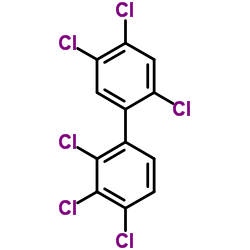2,2',3,4,4',5'-PCB

2,2',3,4,4',5'-PCB structure
|
Common Name | 2,2',3,4,4',5'-PCB | ||
|---|---|---|---|---|
| CAS Number | 35065-28-2 | Molecular Weight | 360.878 | |
| Density | 1.6±0.1 g/cm3 | Boiling Point | 400.0±37.0 °C at 760 mmHg | |
| Molecular Formula | C12H4Cl6 | Melting Point | 80°C | |
| MSDS | Chinese USA | Flash Point | 196.0±23.9 °C | |
| Symbol |


GHS08, GHS09 |
Signal Word | Warning | |
|
Associations of accumulated exposure to persistent organic pollutants with serum lipids and obesity in an adult cohort from Southern Spain.
Environ. Pollut. 195 , 9-15, (2014) The aim of this research was to study the association of the accumulated human exposure to persistent organic pollutants with serum lipid levels and obesity, in a cohort of 298 adults. In the multivariable analyses, HCB concentrations evidenced a significant ... |
|
|
Fish intake and breastfeeding time are associated with serum concentrations of organochlorines in a Swedish population.
Environ. Int. 51 , 88-96, (2013) Persistent organic pollutants (POPs) exert harmful effects on cognitive, endocrine and immune functions and bioaccumulate in the environment and human tissues. The aim of this study was to investigate the body burden of several POPs in the adult population (n... |
|
|
Species differences in the tissue distribution of catechol and methylsulphonyl metabolites of 2,4,5,2',5'-penta- and 2,3,4,2',3',6'-hexachlorobiphenyls in rats, mice, hamsters and guinea pigs.
Xenobiotica 35(1) , 85-96, (2005) Polychlorinated biphenyls (PCBs) are metabolized to phenolic or methylsulphonyl PCBs (MeSO(2)-CBs) in animal species. The study determined the species differences in the tissue distribution of persistent PCB metabolites in rats, mice, hamsters and guinea pigs... |
|
|
Genotoxic effects of polychlorinated biphenyls (PCB 153, 138, 101, 118) in a fish cell line (RTG-2)
Toxicol. In Vitro 25(5) , 1045-52, (2011) Highlights ► We investigate the genotoxic effects of some PCBs (153, 138 and 118 non-dioxin-like compounds and 101 non-dioxin-like compound in fish cells RTG-2. ► The loss of DNA integrity is considered as an initial step for the identification of genotoxic e... |
|
|
Different effects of PCB101, PCB118, PCB138 and PCB153 alone or mixed in MCF-7 breast cancer cells.
Food Chem. Toxicol. 46(7) , 2561-7, (2008) Polychlorinated biphenyls (PCBs) are ubiquitous, persistent environmental contaminants that can be a potential health hazard. In the present study we analyzed the potential estrogenic effect in MCF-7 cells of four biologically relevant PCB congeners, alone or... |
|
|
Serum concentrations of indicator PCB congeners in the Czech adult population.
Chemosphere 72(8) , 1124-31, (2008) In 2006, levels of seven indicator polychlorinated biphenyl congeners (PCB28, 52, 101, 118, 138, 153, and 180) in blood serum of 202 blood donors residing for more than 2 years in five urban areas included in the Czech Human Biomonitoring project were measure... |
|
|
Biological monitoring of indoor-exposure to dioxin-like and non-dioxin-like polychlorinated biphenyls (PCB) in a public building.
Toxicol. Lett. 213(1) , 116-21, (2012) The release of PCBs from sealant material in public buildings and the resulting indoor air levels have raised growing concerns about possible human health effects connected with this exposure. Ambient monitoring of PCBs in a public building has revealed a con... |
|
|
Pesticide contamination profiles of water, sediment and aquatic organisms in the effluent of Gaobeidian wastewater treatment plant.
Chemosphere 72(8) , 1145-51, (2008) Organochlorine pesticides (OCPs, including DDT, HCH and HCB) and six indicator polychlorinated biphenyls (PCB 28, 52, 101, 138, 153, and 180) were measured in water, sediment, zooplankton, fish and Chinese softshell turtle (Pelodiscus sinensis) from Gaobeidia... |
|
|
Parental smoking and neonatal serum levels of polychlorinated biphenyls and hexachlorobenzene.
Pediatr. Res. 47(5) , 598-601, (2000) Polychlorinated biphenyls (PCB) and hexachlorobenzene (HCB) are ubiquitous compounds that have tumor-promoting properties if applied together with tobacco-specific carcinogens. It was the purpose of the present study to investigate whether parental smoking by... |
|
|
DDE in mothers' blood during pregnancy and lower respiratory tract infections in their infants.
Epidemiology 21(5) , 729-35, (2010) Dichlorodiphenyldichloroethylene (DDE) and other organochlorines suppress immunity biomarkers in animals and humans. Our aim was to study the association between prenatal levels of DDE and lower respiratory tract infection in infants independently from polych... |